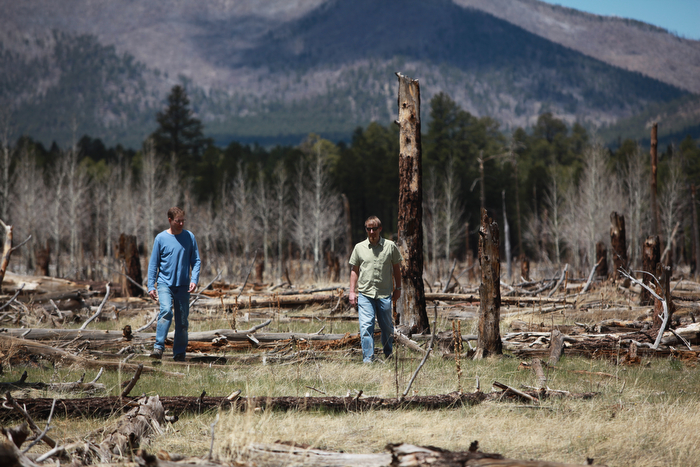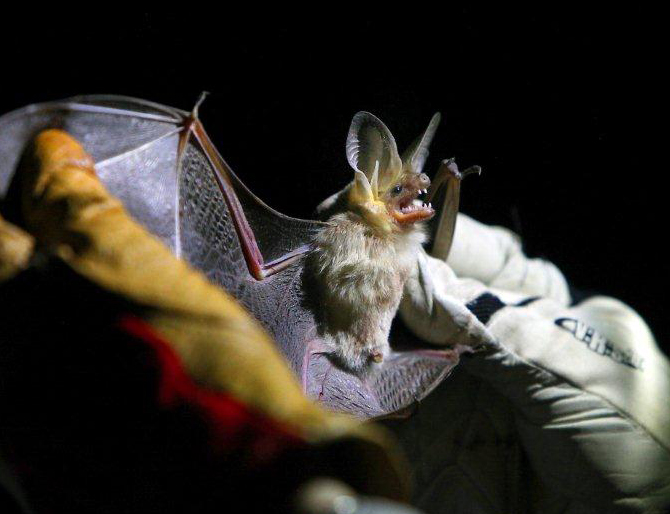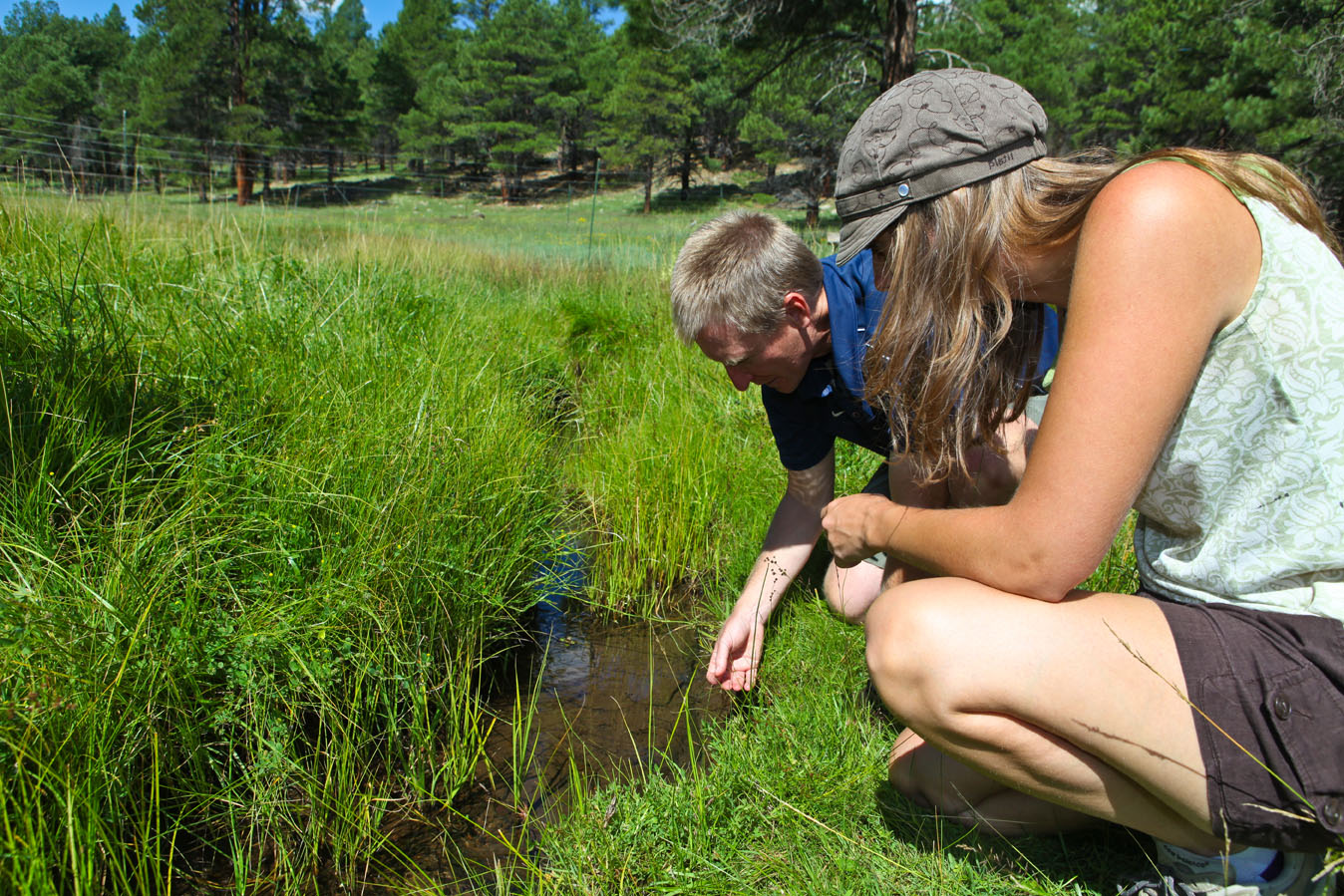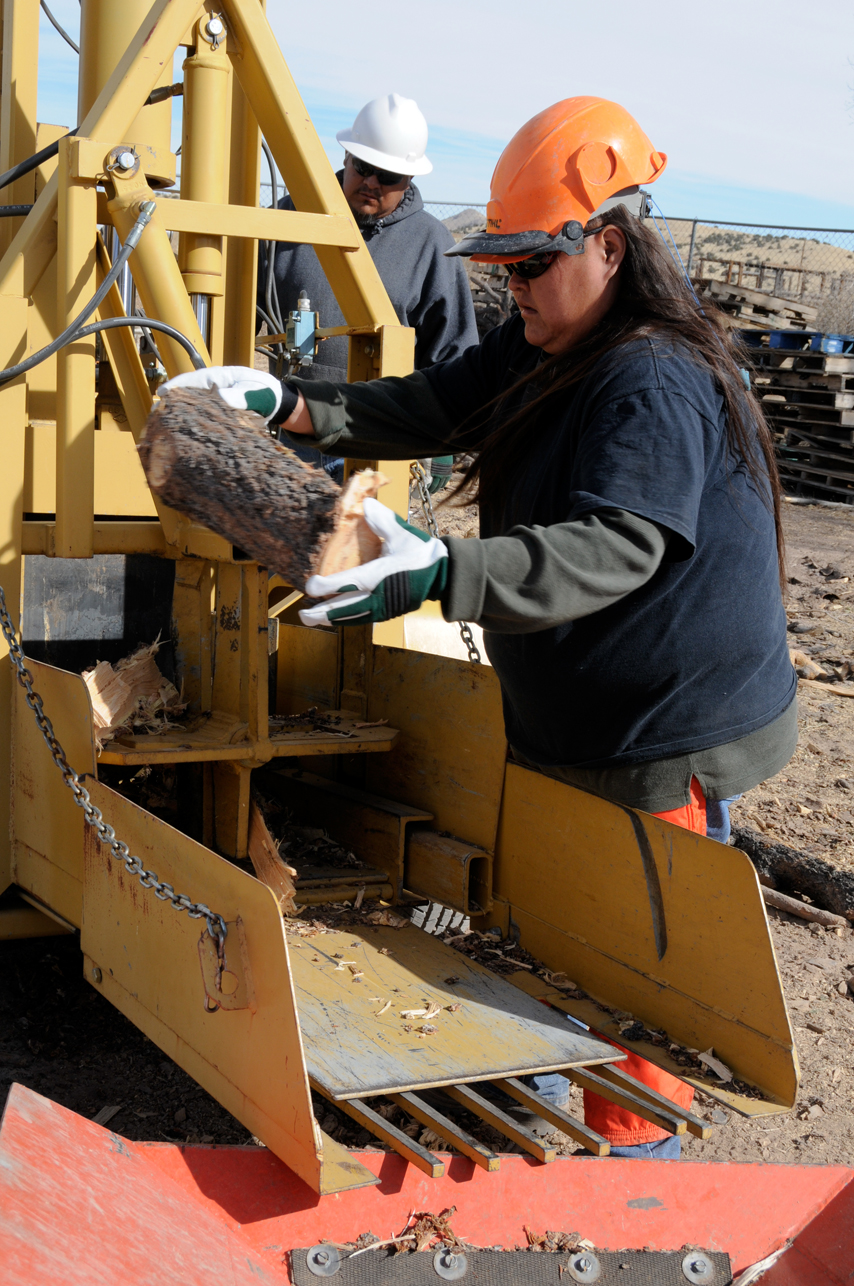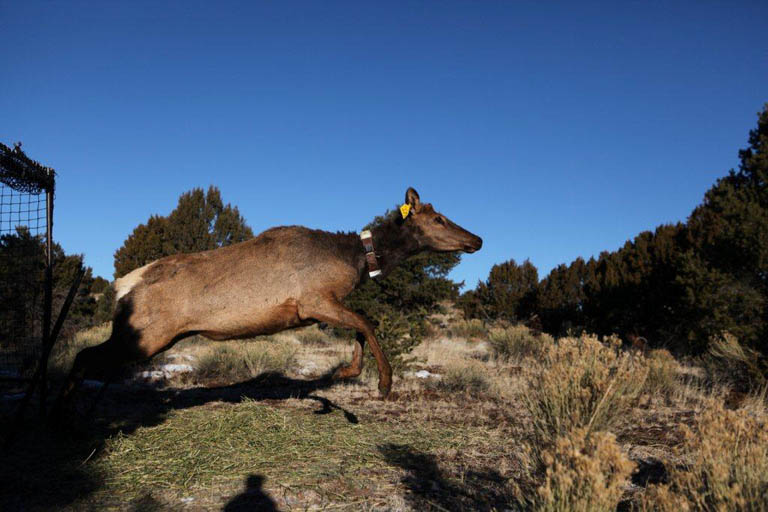Crown Fires and Greenhouse Gases
Large, unnatural crown fires making headlines are upsetting the carbon balance, both while they are burning and for years to come. This, scientists say, is contributing to global warming. While we all know trees breathe in carbon dioxide, how long they can hold onto it affects the amount of greenhouse gases in the atmosphere. Charred logs, standing dead tree trunks and decaying branches mark the site of the 1996 Hochderffer fire, a crown fire that burned 16,000 acres west of the San Francisco Peaks. Forest ecologist Mike Stoddard with the Ecological Restoration Institute at Northern Arizona University has been looking for a sign, any sign, of ponderosa pine seedlings 15 years after the fire. "These large fires are devastating our forests," said Stoddard. "We're concerned that ponderosa pine is not regenerating after these wildfire events." Scientists also are concerned about the invisible impacts of these fires that burn through the treetops. Forest ecologist Dr. Matthew Hurteau with NAU's School of Earth Sciences and Environmental Sustainability says there are two types of emissions associated with wildfire. "Direct emissions happen when fire burns up the biomass or plant material like pine needles on the trees. Then there are indirect emissions. Over time, the stuff that's left in the woods, the dead decomposing trees, is emitting carbon dioxide into the atmosphere." In research conducted from 2001 to 2007, Hurteau says wildfire emissions in the United States were equivalent to 4 to 6 percent of all our nation's emissions from burning coal, oil and natural gas. The percentage of lingering indirect emissions is even greater. "We're looking to forests to take in carbon, thereby lowering the greenhouse gases. But at a site like the Hochderffer fire, the grassy vegetation that's growing in is not making up for the amount of carbon that's being released from the dead trees." DIFFERENT SITE, SAME STORY Across Highway 180, the story is much the same. NAU School of Forestry professor and tree physiologist Dr. Tom Kolb is calculating the amount of carbon dioxide moving between the land and the air at the site of the Horseshoe Fire. This 8,000-acre crown fire also burned in 1996. Above the rotting logs, carbon dioxide is flowing through claw-like fingers of a device called an eddy covariance system. Funded by a U.S. Department of Agriculture National Research Initiative grant, Kolb is measuring gases being released from deforested and forested sites. "The fire has had a long-term legacy effect on the capacity of this site to take in and store carbon dioxide. Prior to the fire, this was a dense forest that would take in somewhere between 100 and 200 grams of carbon per square meter per year. Now it's actually releasing carbon dioxide into the atmosphere at a rate of 50 to 100 grams of carbon per square meter per year. That release is greater than the uptake via photosynthesis by the sparse coverage of grasses and shrubs that came in after the fire. This site has gone from being a carbon sink, where carbon was being stored, to a carbon source, where carbon is being released." Burnt remains of intense fires dot Southwestern ponderosa pine forests. Forest Service silviculturist David Lawrence walks through the decomposing wood of the Cerro Grande fire that burned 48,000 acres 11 years ago near Santa Fe, N.M. "The changes have been noticeable and measurable over time regarding the fire length and severity," said Lawrence. "Since settlement times, with livestock grazing and fire suppression, the forests have gotten much denser and the fire behavior is much different than it used to be. It may be a...
Read MoreBats Offered Alternative to Haunted Houses
Bats Offered Alternative to Haunted Houses This time of year we often associate bats with haunted houses, but houses don’t have to be haunted to attract these creatures of the night. Wildlife biologists say the large, standing dead ponderosa pine trees that many bats prefer are not abundant in our Southwestern forests anymore. So instead of crawling under the loose bark of snags to roost or raise their young, bats may be choosing to live with you, under the eaves of your home. To solve this shortage-in-bat-housing problem, Northern Arizona University School of Forestry graduate student Liz Mering is introducing bat condominiums to the forest neighborhood. “We have two kinds of artificial roosts that mount onto the trunks of large trees and mimic the exfoliating-bark characteristics of dead, old ponderosas pines. One is made of wood and looks like a one-foot by one-foot wedged box. The other is made of resin. It’s molded and painted to look like bark.” Mering has posted 104 artificial roosts in trees around Flagstaff in the last two years. Half are wooden; half are resin. She says it’s too early to tell which kind the bats like better, but wildlife biologists prefer the resin roosts. They are made of the same material you find in boats, so they’re durable, lasting as long as the bats themselves, up to 30 years in the woods. And because they look so much like the bark of a ponderosa pine, they are fooling both the bats and their predators. Unfortunately, they are also expensive, about $50 each. Noting the importance of bats in the ecosystem, the Forest Service has purchased 50 of these to ofer bats more habitat. “Bats have gotten a bad reputation because people often associate them with rabies,” says Red Rock Ranger District Wildlife Biologist Janie Agyagos. “But less than half of 1 percent of the bat population actually carries the rabies virus. Instead, bats provide many benefits to the forest.” Those benefits include fertilizing the soil with their guano, pollinating certain plants, and the big one, eating a lot of insects. Of the 28 bat species squeaking and echo-locating across Arizona’s dark skies, 20 different kinds live in northern Arizona. Most weigh less than half a Hershey’s chocolate bar, but these ravenous nocturnal creatures are eating far more than their weight in pests. “One bat can eat 600 mosquitos in an hour,” says Agyagos. “The desert pallid bat found in Sedona can pick up scorpions and millipedes off the ground and fly away with them.” Keeping up with that appetite is exhausting, so finding a safe place to rest is critical to the bats’survival. “We have a lot of trees in the forest, but not a lot of big trees,” says NAU School of Forestry Wildlife Ecology Professor Dr. Carol Chambers. “The bats we are studying are using trees with 25- to 30- inch diameters. With human-caused changes to the forest structure during the last century, we don’t have as many big, old trees as we once did, trees that will die and become bat habitat. While forest restoration efforts eventually will result in more big old trees, we’re hoping to be able to provide viable bat habitat in the meantime.” By attaching a large bag that looks like a wind sock to the bat boxes, Mering is able to briefly capture the bats when they leave the roosts and examine them for disease and gender. “We’ve gotten a lot of use based on mostly non-reproductive single bats. We’re hoping in a few more years we’ll get more use as many bats find them and remember them.” If female bats set up maternity colonies and begin raising their pups in the artificial bat homes, researchers say they’ll have found a...
Read MoreReturning the Wet to Wetlands
Most of us would simply call it mud, but to wetland biologists, dark messy, sloshy soil is as good as gold in the arid Southwest, oozing with organically rich potential. Early settlers found a lot of it. They described pools of water, knee-deep grasses, narrow streams and fertile soil as they passed through Arizona’s high country. But scientists are concerned that many of our seeps and springs are drying up. While plotting a route from Arkansas to California in 1857, Navy Lieutenant Edward Fitzgerald Beale raved about the fresh water and lush vegetation of the Little Colorado River near Winslow. “The soil seems fertile and bears good meadow grass in all parts,” he wrote, “while the plains, extending from its banks as far as one can see, are covered with rich grama grass.” A visit there today might make you wonder if Beale had been trotting his camels across some other territory. Now 50 percent of what the Little Colorado holds is silt and much of its banks are stripped of native vegetation. After wading through 150 years of human-caused changes on the land that included the exclusion of fire and many, many grazing cows and sheep along with the introduction of Rocky Mountain elk, researchers believe pioneers experienced a much different northern Arizona than what we see today. “The very first explorers would have moved through an area that had very open forests in the uplands. They would have come through one meadow after another as they worked their way from east to west across this region,” said Dr. Jim Allen, executive director of Northern Arizona University’s School of Forestry. Those spongy, muddy, spring-fed meadows, similar to one near Forest Highlands at Griffith’s Spring, kept a variety of plants and animals well watered. “Those floodplains would have had different kinds of wildlife, like beavers that have been hunted out. There would have been very different kinds of plants. In many cases the area would have been too wet for ponderosa pines,” said Allen. “Imagine how much water might have been stored in acres and acres of wet meadow, five, six, maybe 10-feet deep before hitting bedrock, gradually releasing water downstream over time.” Now much too often, deeply eroded gullies quickly whisk water away. Dry meadows carry only memories of old stream channels. And scientists like Dr. Abe Springer, director of NAU’s School of Earth Sciences and Environmental Sustainability, say our overcrowded pine forests are draining the wetlands. “If we return forest density to more of a presettlement, open condition, our studies show we should increase the surface runoff and recharge aquifers by decreasing the amount of water that trees and other kinds of vegetation use.” Even after 15 years of drought, a healthy hum is beating on the wings of hundreds of dragonflies at Hoxworth Springs, a restored site south of Lake Mary. “In these types of seeps and springs, dragonflies are the top predators,” said Springer. “They are the carnivores of their world and a very good indicator of a high quality condition.” Another good indicator is a high concentration of graminoids, says NAU School of Forestry student researcher Karissa Ramstead. “A graminoid is a grass-like species. You want to see a high percentage of sedges and rushes in the vegetation along streams. They help stabilize the banks.” By removing some of the trees in the surrounding uplands, rebuilding shallow streams, reducing the impact of grazing animals, and reintroducing fire, researchers are confident we can return the wet to wetlands....
Read MoreCutting Edge Jobs
April 15, 2011 Contact: bonnie.stevens@gmail.com For Immediate Release 928-380-4349 Cutting-edge Jobs Supported by Old Wood Flagstaff, Ariz. – Hope for forests and communities at risk is spreading like wildfire in an isolated village south of Albuquerque. Northern Arizona University ecologists say what’s happening on the Alamo Navajo Reservation could well be a model for forest restoration across the Southwest where there are too many trees and not enough jobs. In a small lumberyard in Socorro, N.M., young adults are learning how to cut down trees, operate logging equipment and split firewood. Derek Padilla is the crew leader. “This project is helping me because it’s near my home on the reservation.” The Alamo Navajo Reservation consists of only about 2,000 people. Nearly 70 percent are unemployed and most are living below the national poverty level. Nearby is the Cibola National Forest, unnaturally thick with pinyon and juniper trees. The area is considered New Mexico’s most dangerous place for homes and businesses during fire season. “We’ve removed natural fire from a lot of the ecosystems throughout the West,” says Wally Covington, Arizona’s director for the Southwest Ecological Restoration Institutes and Regents’ Professor. “That has allowed forests to build up these ground fuels and ladder fuels and that’s what we’re trying to deal with across millions of acres. We’re trying to mimic what science tells us would be a more natural condition.” To achieve this desired condition, Covington says a trained labor force and a market for small diameter trees will be essential. In the Alamo Navajo Project, SWERI is providing training along with equipment, such as wood splitters and yarders. The collaboration also includes financial and in-kind assistance from the U.S. Forest Service. “A similar model could help facilitate efforts in northern Arizona where the nation’s largest forest restoration project, the Four Forest Restoration Initiative, is in the planning stages,” says Covington. The 4FRI aims to treat some 2.4 million acres of ponderosa pine across the Mogollon rim during the next 20 years. NAU researchers are providing ecological restoration science findings to the Forest Service to achieve landscape-scale forest health. “We now have people here who are trained in felling, trained in primary processing and trained in restoration monitoring,” says New Mexico’s SWERI Director Andrew Egan. “They are really making New Mexico forests healthier and making New Mexico a safer place to be because we are reducing the impacts of potential wildfires.” With the restoration institutes, the Alamo Navajo School Board has created a wood products program out of trees that nobody wanted. “We sell firewood all over the country,” says the school board’s Natural Resource Specialist Bill Ferranti. “Our biggest market is in west Texas. We shipped some to Chicago. We shipped some to North Carolina. We shipped more than 300 cords last year.” It’s a collaboration supported by Old Wood. Owner David Old is building a business out of sticks and branches in Las Vegas, N.M. “The whole plant is really scaled and geared for making flooring from smaller trees. We are not about cutting down the big trees.” If his idea stacks up, Old will construct a new foundation for some 50 employees in a $2-million-dollar a year operation. Old Wood’s first order for pinyon wood flooring cut by the Alamo Navajo crew is scheduled to go to a San Francisco restaurant. ### Feature...
Read MoreCollars and Corridors
Elk are roaming around the woods with collars around their necks. In the forest near Flagstaff, elk are being outfitted to tell researchers what they and other animals need to navigate through urban sprawl, climate change and large restoration projects. For Arizona Game and Fish Department wildlife biologist Jeff Gagnon, the job of collaring an elk is somewhat like a rodeo event. Within minutes, he and a team of wildlife managers can calm a frightened animal that might weigh as much as a thousand pounds. “We fit the collar to make sure the animal has some space and isn’t being choked,” he says. The collar is programmed to fall off in a few months. But in the meantime, every two hours a GPS unit is sending signals to satellites that are sending signals to biologists. Gagnon has been tracking some 130 elk around major highways including interstates 17 and 40. “We know where the animals are, what kind of habitat they are using and what barriers are stopping them. For a lot of animals when we fragment their habitat, they can’t get to resources like summer or winter range. We also run the risk of isolating or breaking up the herd, which can lead to a smaller gene pool and a weaker species.” Researchers like Northern Arizona University’s Dr. Paul Beier, a conservation biology and wildlife ecology professor in the School of Forestry, says this information is critically important to keep animals from stepping into danger or even extinction. “With climate change, we have the situation where habitat is literally moving out from under the feet of wildlife,” he says. “In order for these species to stay where they are, in terms of a healthy population, they have to move.” Beier is developing maps detailing links for wild areas, or wildlife corridors, to help land managers understand how animals move across the land. “We’re creating landscapes that are more permeable than the landscapes we had a decade or two decades ago,” he says. “If you provide habitat for the large species, you bring the others along,” says Arizona Game and Fish Department Habitat Program Manager Sarah Reif. “Elk, mule deer, pronghorn antelope – these are the big guys we manage for because of public safety on highways and roads, and because they have the biggest home ranges.” Pronghorn have long been a symbol of the West, but researchers say barriers like canals, fences and highways have had a substantial impact on the population. “In Arizona, the numbers declined from about 45,000 animals in the early 1900s to roughly 7,500 in 2002.” says Reif. “Since then we have recovered the population to somewhere around 11,000 but we still have a lot of work to do to connect pronghorn habitats.” With information about wildlife movement, highways are becoming less of a hindrance, and safer for wildlife and people. Groups like the Arizona Department of Transportation, Elk Society, Rocky Mountain Elk Foundation and Federal Highway Administration are funding research and passageways. For example, along State Route 260 near Payson, highway improvement projects have included wildlife crossings. “Animals are using the crossings,” says Gagnon, “and collisions between elk and motorists have been reduced by at least 85 percent.” The Ecological Restoration Institute at NAU’s Executive Director Dr. Wally Covington says managing for wildlife corridors is increasingly important as forests are restored on a landscape scale. “Across hundreds of thousands of acres, natural habitat can be restored. Wildlife can self-regulate. Predator prey dynamics can keep populations in a sustainable, steady state that’s characteristic of the evolutionary environment.” Wearing high-tech necklaces, today’s elk may well...
Read More
